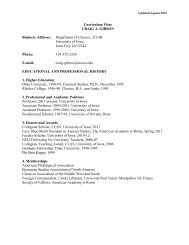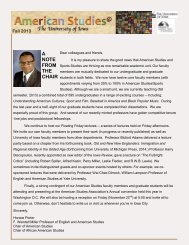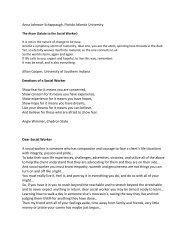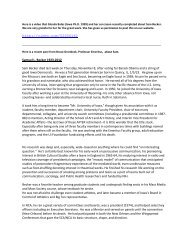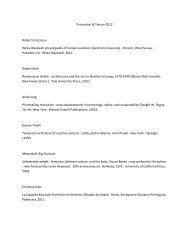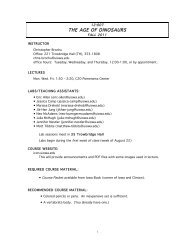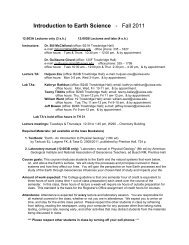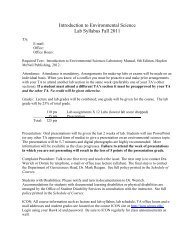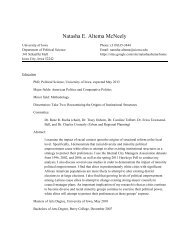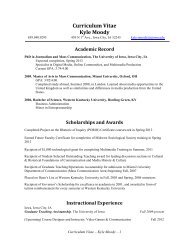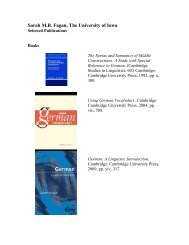German fricatives: coda devoicing or positional faithfulness?
German fricatives: coda devoicing or positional faithfulness?
German fricatives: coda devoicing or positional faithfulness?
You also want an ePaper? Increase the reach of your titles
YUMPU automatically turns print PDFs into web optimized ePapers that Google loves.
262 Jill Beckman, Michael Jessen and Catherine Ringen<br />
is, on the other hand, strong supp<strong>or</strong>t f<strong>or</strong> the position we have argued f<strong>or</strong> in<br />
this paper, namely that while stops in <strong>German</strong> contrast f<strong>or</strong> [sg], <strong>fricatives</strong><br />
contrast f<strong>or</strong> [voice].<br />
5.4 Phonetic enhancement<br />
Another alternative is that the contrast is one of [sg], but that the voicing<br />
occurs not as a result of phonetic passive voicing, but as a result of ‘phonetic<br />
enhancement’ (Avery & Idsardi 2001). The idea is that the [sg]<br />
contrast in <strong>fricatives</strong> is enhanced by voicing the non-spread <strong>fricatives</strong>.<br />
Such an analysis avoids the criticism that there is no phonetic reason f<strong>or</strong><br />
passive voicing of a w<strong>or</strong>d-initial non-spread fricative, since this is not an<br />
environment in which passive voicing is expected to occur. Enhancement<br />
occurs because it heightens a contrast. But this idea raises other questions.<br />
One problem with the enhancement position is that it is not clear why<br />
<strong>fricatives</strong> in <strong>German</strong> are enhanced with the [voice] feature, but stops are<br />
not. Consider the facts of another <strong>German</strong>ic language, Swedish. Swedish<br />
has both prevoiced stops and aspirated stops in its surface invent<strong>or</strong>y<br />
(Ringen & Helgason 2004, Helgason & Ringen 2008). It might be suggested,<br />
theref<strong>or</strong>e, that like <strong>German</strong>, stops contrast f<strong>or</strong> the feature [sg], but<br />
that the voicing in Swedish is attributable to ‘phonetic enhancement’.<br />
This leaves unanswered the question of why there should be enhancement<br />
of Swedish stops, but not of stops in <strong>German</strong>.<br />
M<strong>or</strong>eover, if the fact that <strong>German</strong> stops are only rarely prevoiced were,<br />
in fact, attributed to phonetic enhancement with the [voice] feature, we<br />
would expect the voicing in the (phonetically enhanced) <strong>fricatives</strong> to be<br />
similarly variable. Yet we see little <strong>or</strong> no variability in the voicing of intervocalic<br />
and initial <strong>fricatives</strong> in <strong>German</strong>. The point is that the [spread]<br />
analysis of stops and <strong>fricatives</strong> with phonetic enhancement predicts a<br />
parallelism in the voicing behaviour of stops and <strong>fricatives</strong> which simply<br />
isn’t there: voiced <strong>fricatives</strong> are less prone to a voiceless realisation than<br />
‘voiced’ stops in <strong>German</strong>.<br />
This lack of parallelism in voicing variability in stops and <strong>fricatives</strong> is<br />
brought into focus when we consider the relationship between voicing<br />
percentage and fricative duration. C<strong>or</strong>relation and regression of voicing<br />
percentage against total fricative duration were calculated. If there is a<br />
strong negative c<strong>or</strong>relation between voicing percentage and fricative duration,<br />
this means that with progressively longer fricative durations, the<br />
percentage of voicing becomes lower. Such a pattern would be expected<br />
aerodynamically, because the longer the fricative becomes, the m<strong>or</strong>e difficult<br />
it is to maintain voicing throughout closure. It could be argued that<br />
with active voicing due to underlying [voice], such a pattern should not<br />
occur, because the speaker would use active means to prevent cessation of<br />
voicing. When the voicing percentage was plotted against fricative duration<br />
f<strong>or</strong> all non-syllabic predicted voiced tokens, it was found that tokens<br />
with 100% voicing occurred throughout most of the range of fricative<br />
durations. It is only in the <strong>fricatives</strong> with durations in the top 20% range




